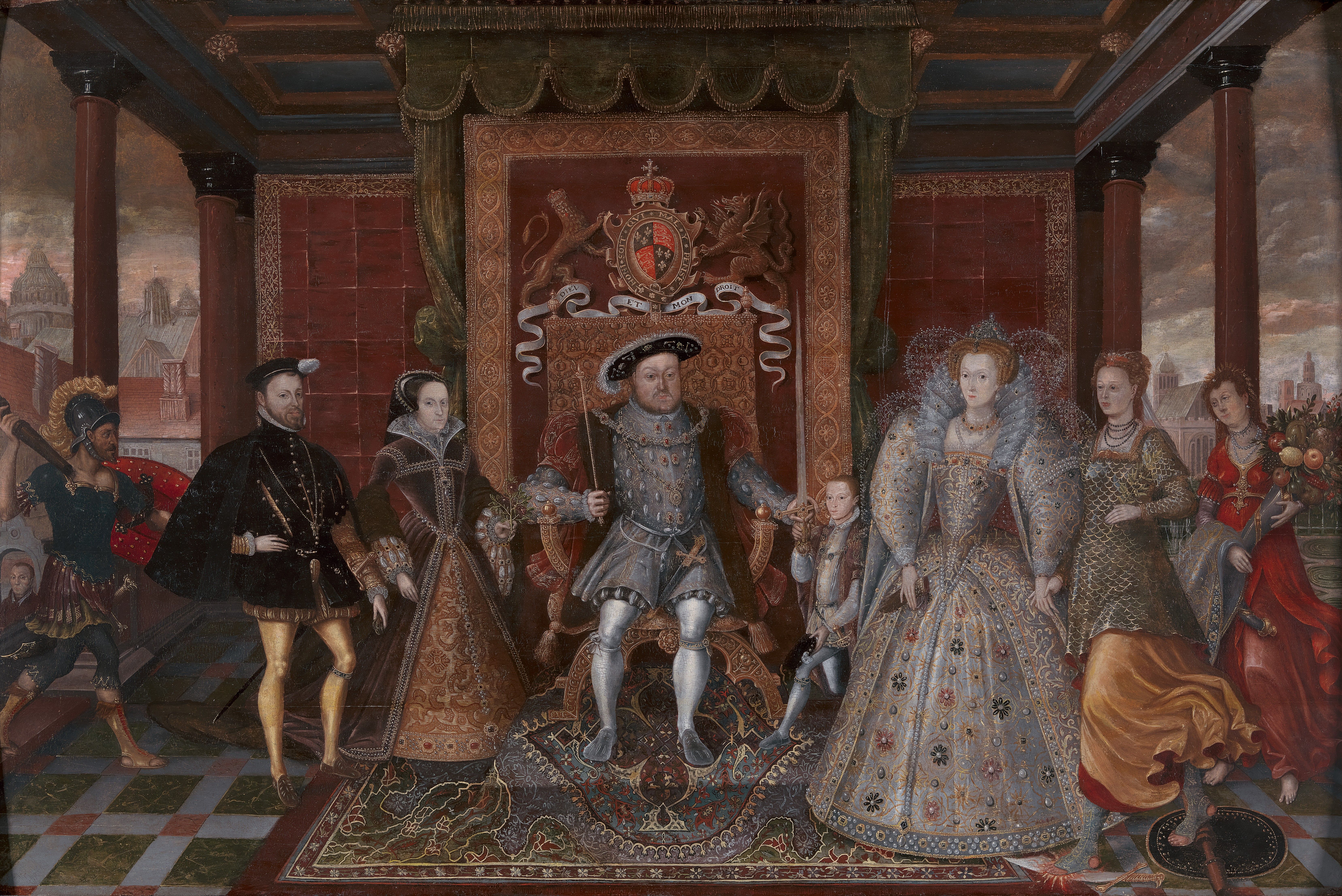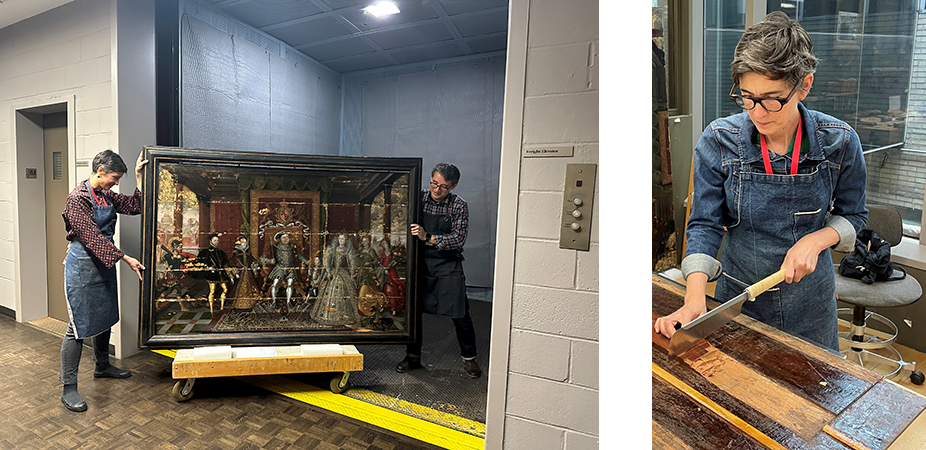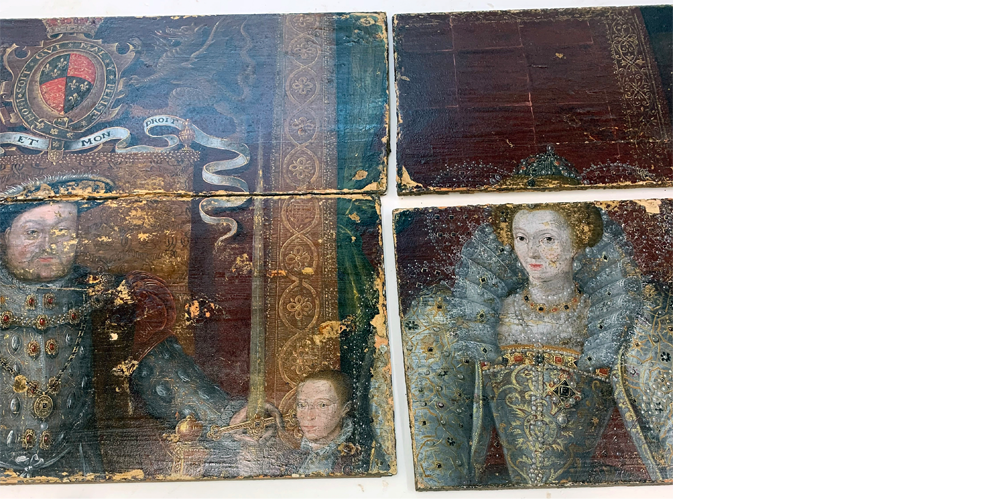The complex construction of An Allegory of the Tudor Succession required YCBA conservators to collaborate closely with specialists at the Metropolitan Museum of Art. During the second phase of treatment, panel paintings conservators at the Met began structural treatment on the large panel, including the separation of its unstable boards.

Unknown artist, An Allegory of the Tudor Succession: The Family of Henry VIII, ca. 1590, oil on panel, Yale Center for British Art, Paul Mellon Collection
In April 2023, Kristin Holder and Alan Miller, panel paintings conservators at the Metropolitan Museum of Art, New York, began to treat the support of the sixteenth-century painting An Allegory of the Tudor Succession, which is the only painted depiction of the Tudor monarchs in the collection of the Yale Center for British Art. The panel had begun to come apart along the joins, prompting conservators at the YCBA to collaborate with specialists in panel painting conservation at another institution.
The first phase of treatment took place at the YCBA. Over a period of ten months, Jessica David, Senior Conservator of Paintings, removed the discolored varnish and some previous restoration work. Technical analysis of the painting revealed a range of pigments, including smalt—a form of blue that is notoriously unstable. Exposed parts of the painting’s skies, where the smalt had darkened over time, had been aggressively cleaned by an earlier conservator. Removing the varnish revealed the extent of damage to the panel, especially where the different boards met.
Before the painting traveled to the Met, it was documented by the YCBA’s imaging department. These images help track the progress of the treatment as the work is touched by various hands and travels to different places. The panel was then carefully packed for transport.
At the Met, Holder and Miller began treating the painting by removing the wooden battens that were glued to the back during an earlier restoration. The battens were made from a tropical hardwood, which behaves differently from the five horizontally grained Baltic oak boards that make up the panel. Once the battens were taken off, the conservators gained access to the back of the painting. This process also provided Holder and Miller an opportunity to clean the joins, where old hide glue had oxidized.

Panel paintings conservators Kristin Holder and Alan Miller received the painting at the Met (left), where Holder removed the battens from the back of the painting (right)
Viewing the panel without the battens allowed the Met conservators to gain a richer understanding of the painting’s treatment history. They believe that the painting had been taken apart at least once in the past, but to date, no record of this has been found. Conservators at both institutions noticed disruptions in specific pictorial elements. When the boards were rejoined, the surface was not entirely level. Certain compositional features on the front of the painting were not properly aligned as a result.
Once the battens were removed and the boards were separated, Holder and Miller began to take off the thick coating of shellac that covered the battens and the back of the boards. Holder suspected the coating was added by previous conservators as a moisture barrier, but over time the shellac had become an added source of constraint on the conservation of the painting.

Detail of panel pieces of An Allegory of the Tudor Succession, photo by YCBA staff
To dissolve the shellac, Holder placed alcohol gel onto the back of the painting and covered the gel with sheets of Mylar. The gel slowly softened the shellac, allowing Holder to remove it from the wood without damaging the panel. She worked in sections across the back of the painting until the shellac was removed.
While the work was dismantled, the panel conservators were also able to address aberrations in the compositions from cross-grain cuts in the boards. Holder and Miller are not sure why two of the five boards were cut, but one theory is that the boards were severed to remedy a twist in the wood. Cutting one of the panel’s boards would have relieved some of the stress this tension placed on the panel. When the pieces of one board were glued back together, a small insert was added. Holder and Miller decided to remove the insert, which was not the right size.
In spring 2024, Holder and Miller will begin to rejoin the painting, putting a less aggressive system of support in place. Next, the painting will return to New Haven for the final stage of the treatment: retouching by YCBA conservators. When the work has been restored, it will be included in the reinstallation of the YCBA’s collection, which will be on view when the museum reopens in spring 2025.
Conserving “An Allegory of the Tudor Succession” — Phase 1
During the first phase of treatment, Jessica David, Senior Conservator of Paintings, removed the discolored varnish and some previous restoration.